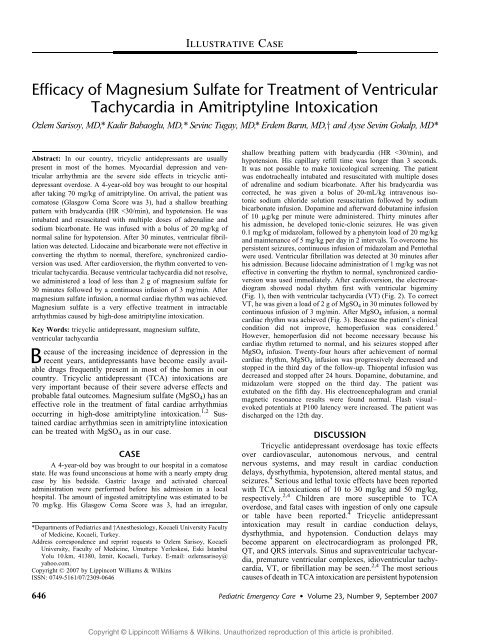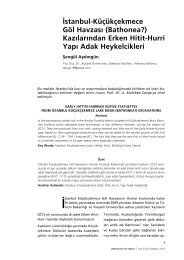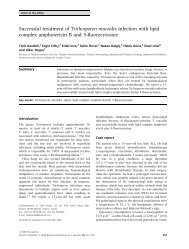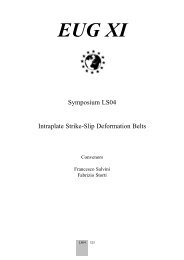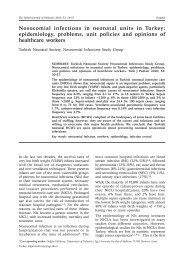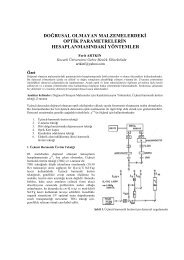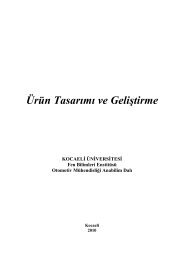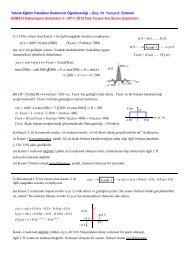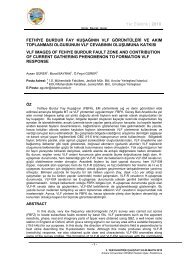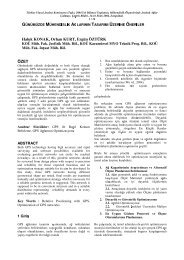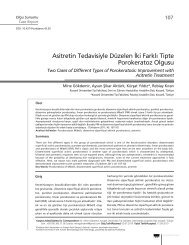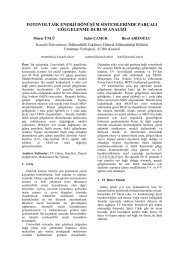Efficacy of Magnesium Sulfate for Treatment of Ventricular ...
Efficacy of Magnesium Sulfate for Treatment of Ventricular ...
Efficacy of Magnesium Sulfate for Treatment of Ventricular ...
Create successful ePaper yourself
Turn your PDF publications into a flip-book with our unique Google optimized e-Paper software.
<strong>Efficacy</strong> <strong>of</strong> <strong>Magnesium</strong> <strong>Sulfate</strong> <strong>for</strong> <strong>Treatment</strong> <strong>of</strong> <strong>Ventricular</strong><br />
Tachycardia in Amitriptyline Intoxication<br />
Ozlem Sarisoy, MD,* Kadir Babaoglu, MD,* Sevinc Tugay, MD,* Erdem Barın, MD,y and Ayse Sevim Gokalp, MD*<br />
Abstract: In our country, tricyclic antidepressants are usually<br />
present in most <strong>of</strong> the homes. Myocardial depression and ventricular<br />
arrhythmia are the severe side effects in tricyclic antidepressant<br />
overdose. A 4-year-old boy was brought to our hospital<br />
after taking 70 mg/kg <strong>of</strong> amitriptyline. On arrival, the patient was<br />
comatose (Glasgow Coma Score was 3), had a shallow breathing<br />
pattern with bradycardia (HR
Pediatric Emergency Care Volume 23, Number 9, September 2007 MgSO4 <strong>for</strong> Tachycardia in Amitriptyline Intoxication<br />
FIGURE 1. Nodal rhythm with bigeminy ventricular complexes.<br />
caused by myocardial depression, ventricular tachycardia, and<br />
ventricular fibrillation. In TCA intoxication, sodium bicarbonate<br />
treatment is suggested as the first agent. Sodium<br />
bicarbonate is known to decrease ventricular arrhythmia<br />
frequency, prevent QRS prolongation, and correct hypotension.<br />
This effect can be accentuated by increasing plasma<br />
sodium concentration and alkalinization. 4,5 Increasing plasma<br />
sodium concentration may prevent cardiac arrhythmias by<br />
decreasing sodium channel inhibition caused by TCA<br />
intoxication. 2,5 It has been reported that alkalinization<br />
decreases heart rate, shortens QRS interval, and corrects<br />
ventricular arrhythmias. 4<br />
FIGURE 2. <strong>Ventricular</strong> tachycardia.<br />
Lidocaine and phenytoin have also been used to treat<br />
dysrhythmias occurring in amitriptyline intoxication. 2,4<br />
<strong>Magnesium</strong> sulfate is efficient in treating sustained<br />
ventricular arrhythmias, especially ventricular and torsade<br />
de pointes tachycardia and is known to prevent sudden<br />
deaths. <strong>Magnesium</strong> plays an important role in maintaining<br />
intracellular potassium levels activating sodium-potassium<br />
adenosine triphosphatase pumps. Intracellular potassium<br />
levels may also be low in presence <strong>of</strong> normal serum levels.<br />
Low intracellular potassium levels have been shown to<br />
decrease membrane threshold potentials and increase<br />
cellular excitability. <strong>Magnesium</strong> infusion is reported to<br />
n 2007 Lippincott Williams & Wilkins 647<br />
Copyright @ Lippincott Williams & Wilkins. Unauthorized reproduction <strong>of</strong> this article is prohibited.
Sarisoy et al Pediatric Emergency Care Volume 23, Number 9, September 2007<br />
FIGURE 3. Normal rhythm after magnesium sulfate treatment.<br />
increase intracellular potassium levels more significantly<br />
than potassium infusion. Antiarrhythmic effect <strong>of</strong> magnesium<br />
is based on this mechanism. 2,6,7 Our patient had<br />
ingested amitriptyline more than the lethal dose. In the<br />
emergency unit, he was comatose, had bradycardia, and<br />
needed resuscitation with adrenaline and sodium bicarbonate<br />
after cardiopulmonary arrest. Sodium bicarbonate infusion<br />
was then started. Phenytoin was loaded 20 mg/kg both as an<br />
anticonvulsant and arrhythmic agent. Lidocaine bolus was<br />
given to treat ventricular fibrillation, and cardioversion was<br />
applied to correct the cardiac rhythm. Fibrillation stopped<br />
after cardioversion, but his cardiac rhythm did not return no<br />
normal. Because his arrhythmia was intractable despite<br />
sodium bicarbonate, phenytoin, and lidocaine infusion, we<br />
started MgSO4 infusion as reported by Citak et al. 2<br />
Considering the possible side effects, MgSO 4 was given 2<br />
g as an infusion <strong>for</strong> 30 minutes, instead <strong>of</strong> bolus, and<br />
continued as 3 mg/min. 2 Hypotension that developed after<br />
30 minutes <strong>of</strong> infusion improved by decreasing the infusion<br />
rate, and no other side effects were seen. His ventricular<br />
arrhythmia stopped, and cardiac rhythm returned to normal<br />
after 30 minutes <strong>of</strong> MgSO4 infusion, and p waves were<br />
apparent. Cardiac rhythm was completely normal in the 12th<br />
hour <strong>of</strong> MgSO4 infusion. Infusion rate was gradually<br />
decreased and stopped on the third day. His arrhythmia<br />
did not repeat.<br />
Our case is the second reported case after that <strong>of</strong> Citak<br />
et al, 2 being important as magnesium is effective in treating<br />
arrhythmia in high-dose amitriptyline intoxication. <strong>Magnesium</strong><br />
sulfate is a very effective treatment in intractable<br />
arrhythmias caused by high-dose amitriptyline intoxication.<br />
REFERENCES<br />
1. Knudsen K, Abrahamsson J. Effects <strong>of</strong> epinephrine, norepinephrine,<br />
magnesium sulfate, and milrinone on survival and the occurrence <strong>of</strong><br />
arrhythmias in amitriptyline poisoning in the rat. Crit Care Med. 1994;22:<br />
1851–1855.<br />
2. Citak A, Soysal DD, Üçsel R, et al. <strong>Efficacy</strong> <strong>of</strong> long duration resuscitation<br />
and magnesium sulphate treatment in amitriptyline poisoning.<br />
Eur J Emerg Med. 2002;9:63–66.<br />
3. Dönmez O, Cetinkaya M, Canberk R. Hemoperfusion in a child with<br />
amitriptyline intoxication. Pediatr Nephrol. 2005;20:105–107.<br />
4. Geis GL, Bond GR. Antidepressant overdose: tricyclics, selective<br />
serotonin reuptake inhibitors, and atypical antidepressants. In: Erickson<br />
TB, Ahrens WR, Aks SE, et al, eds. Pediatric Toxicology: Diagnosis and<br />
Management <strong>of</strong> the Poisoned Child. 1st ed. New York, NY: The<br />
McGraw-Hill Companies; 2005:296–302.<br />
5. Knudsen K, Abrahamsson J. Epinephrine and sodium bicarbonate<br />
independently and additively increase survival in experimental amitriptyline<br />
poisoning. Crit Care Med. 1997;25:669–674.<br />
6. Somberg JC, Cao W, Cvetanovic I, et al. The effect <strong>of</strong> magnesium sulfate<br />
on action potential duration and cardiac arrhythmias. Am J Ther. 2005;12:<br />
218–222.<br />
7. Fawcett WJ, Haxby EJ, Male DA. <strong>Magnesium</strong>: physiology and pharmacology.<br />
Br J Anaesth. 1999;83:302–320.<br />
648 n 2007 Lippincott Williams & Wilkins<br />
Copyright @ Lippincott Williams & Wilkins. Unauthorized reproduction <strong>of</strong> this article is prohibited.


